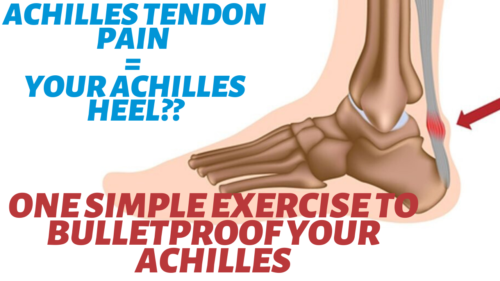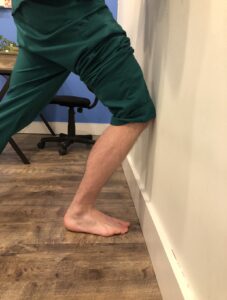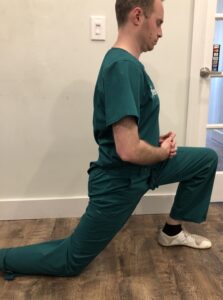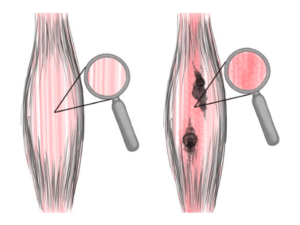
10 Apr Don’t Let Achilles Tendon Pain be your Achilles Heel: One Essential Rehab Exercise You Need To Know
BY: DR. JEFF SCOTT, DC
Have you ever had Achilles Tendon Pain before?
If you have, you probably know that it can be a bit unsettling.
Whether it’s the story of the Greek hero Achilles dying from an arrow to the heel (Achilles Heel, get it?) or the countless athletes we’ve heard tear their Achilles, something about pain in this tendon tends to be a bit unnerving.
What Causes Achilles Tendon Pain?
What an excellent question! In the absence of a traumatic injury, pain in the Achilles most commonly occurs as an overuse injury, when the tendon is placed under unhealthy amounts of repetitive load.
The tissue’s capacity to buffer the extra load slowly diminishes. Over time, this excessive loading causes the tendon to become inflamed, which leads to a host of symptoms, of which pain is one.
What your Friends (and Doctor) Might Not Know About Achilles Tendon Pain!
Oftentimes when someone presents with Achilles Tendon pain, the diagnosis they receive is “Achilles Tendinitis”. In fact, if you were to Google search “Achilles Tendon Pain”, the first link that presents is for the Mayo Clinic and is entitled “Achilles Tendinitis – Symptoms and causes”.
Now, for those of you who don’t know, the term “-itis” means inflammation. Therefore, Achilles Tendinitis simply means inflammation of the Achilles Tendon. Pretty straight forward right?…. Not necessarily.
If your Achilles symptoms have only been present for a short period of time, say a few weeks to a couple months, then Achilles Tendinitis might be the correct diagnosis.
However,
if you’ve had this pain for a long time or have had multiple episodes of Achilles pain, then you might be receiving the wrong diagnosis.
And when you’re in pain the last thing you want is the wrong diagnosis.
For someone who has had long term pain in their Achilles the more appropriate diagnosis might be Achilles Tendinosis.
What is Achilles Tendinosis?
Another excellent question!
If “-itis” means inflammation, then the suffix “-osis” would be synonymous with degenerative changes. When someone is diagnosed with Achilles Tendinosis it means that the fibers that make up the tendon are actually beginning to degenerate due to the chronic overloading they’ve been subjected to.
This is a crucial bit of information to understand because it alters the nature of the condition; thereby shifting the goal of treatment and even the anticipated recovery time.
For a more detailed understanding of the difference between Tendinitis and Tendinosis I strongly recommend you read the blog post THE TRUTH ABOUT ACHILLES TENDINITIS (AND ACHILLES PAIN).
What about this rehab exercise?
Now that you have a clear understanding of the importance of properly diagnosing Achilles Tendon pain, we can cover the exercise advertised in this post’s title.
The Eccentric Heel Drop is a terrific exercise for rehabbing an injured Achilles Tendon and can be successfully implemented whether you have an “-itis” or “-osis” diagnosis.
The reason this exercise works so well is the nature of the movement being performed.
When a muscle or tendon moves “eccentrically” it means that the tissues are being lengthened under tension.
Loading the tendon as it elongates helps build strength and stability amongst the tendon fibers, which are essential for long term tendon health.
This is accomplished by creating load on the tendon, utilizing one’s own bodyweight, in order to stimulate increased blood flow to the Achilles and the surrounding calf tissues. Tendons typically don’t don’t receive the same amount of blood supply that ordinary muscle fibers do.
Therefore, when they get injured, it can take them a lot longer to heal. Using an exercise like the Eccentric Heel Drop is crucial because the increase in blood flow is going to bring more nutrients to the tendon, thereby allowing it to heal much more efficiently.
To see how to perform the Eccentric Heel Drop check out the video below.
But wait there’s more!!!
While the Eccentric Heel drop is an important rehab exercise,
it is by no means the only factor that should be considered.
In fact, whenever someone presents with Achilles Tendon pain, two important ranges of motion that should also be checked are ankle dorsiflexion and hip extension. Having sufficient ankle dorsiflexion and hip extension capacity are important parts of our normal gait pattern.
When these motions become limited, the Achilles Tendon is one of the tissues that can get overloaded.
Think of how many steps you take in an hour, let alone in a single day. If with every step you take the Achilles is being subjected to mildly unhealthy loads of tension, it’s not hard to see how the tendon can become inflamed overtime and how the load can begin to add up.
If this process continues, the tendon is never given an opportunity to heal, which eventually leads to the tendon fibers degenerating.
So what causes these motions to become limited?
Three for three with great questions!
One of the main causes of limited range of motion is adhesion.
Adhesion is a fibrotic substance that our body uses to heal and repair our tissues when they become damaged. When adhesion is present it acts like “glue”, making our muscles weak and less flexible.
Adhesion can also form around nerves, ligaments, and tendons, as well. In fact, not only is adhesion the most common pathology in the human body, it is also the most undiagnosed and most reversible condition.
Not only can adhesion form around the Achilles Tendon, but when it builds up in the muscles involved with ankle dorsiflexion and hip extension, it can limit their ability to lengthen, decreasing those ranges of motions, and thereby causing the Achilles Tendon to become overused and overloaded because it compensates for the load that isn’t being taken care of by the hip and ankle joints
Wrapping It Up!
The good news for you is if you are suffering from Achilles Tendon pain, if you have limited ankle dorsiflexion and/or limited hip extension, and you have adhesion, it’s all treatable by a skilled health care provider.
And you’re in luck! At Barefoot Rehab, we are the ONLY clinic in NJ certified to find and fix adhesion, and we specialize in chronic pain conditions that other providers have been unable to treat!
So the question you have to ask yourself is: “How much longer do I want to be in pain”? If the answer is no more, then you better give us a call!





M.D.Selvam
Posted at 03:48h, 31 JulyI am having pain in my back herl of left leg since just few days advice I am keeping ice pack
Dr. Chris
Posted at 17:18h, 15 AugustK let us know how it goes
Rajiv Ramakrishnan.
Posted at 14:12h, 21 FebruaryI am suffering with pain and slight swelling on my back heal of both legs.It started on left leg first and now am having pain on both legs.Now the left foot left side where the curve starts having severe pain which restrict me to walk properly.Left heal is having a blackish appearance too.Please suggest me some exercise so that I can get rid of this pain.
Rajiv Ramakrishnan.
Dr. Chris
Posted at 22:42h, 26 FebruaryWhy do you assume your problem is a “weakness” problem that can be stretched or strengthened? If it’s swollen or black, something is damaged. Maybe the calcaneal bursa? I recommend getting an MRI before guessing about a treatment that probably won’t work.